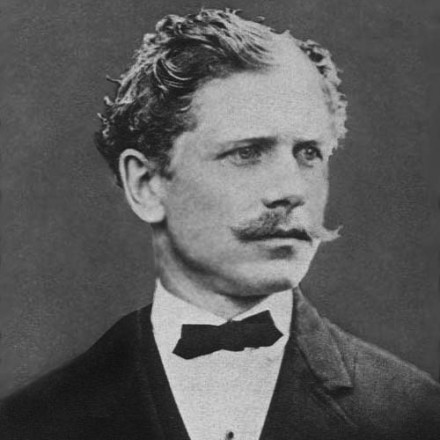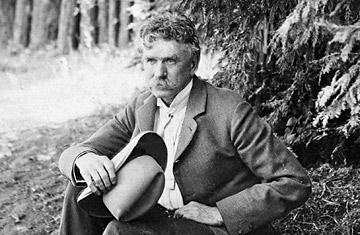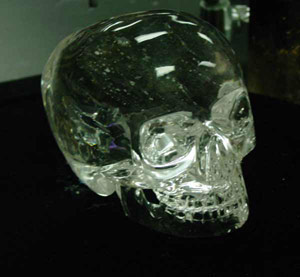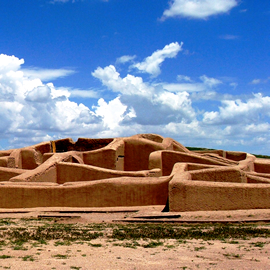

The Mysterious Disappearance of Ambrose Bierce
 By Logan Hawkes
By Logan Hawkes
Ambrose Bierce was a 19th and early 20th century writer, journalist and columnist well known for his open minded way of thinking and his colorful lifestyle.
Above all he was a critic of just about everything. A free thinker, he wasn’t afraid of taking on the establishment, challenging government, religion, science, art – and well noted for his scathing columns in Randolph Hearst’s San Francisco Examiner.
As a published author he provided us with many bone chilling stories of the strange – mysteries, fringe science, stories of death and dying and multidimensional travel, time warps and more.
While Bierce was a serious journalist spending much of his career working for Hearst, he is perhaps best known for his famous Civil War stories. A soldier during the War between the States, he often wrote about his experiences during the conflict.
But more than other single subject,
Bierce favored covering stories of unexplained phenomenon, which he came across many times as a journalist. It is from these interesting unexplained events that his works of fiction were born. His exemplary works in the genre has been credited with inspiring many science fiction writers who followed in the years ahead. He was also fond and accomplished in writing stories involving the paranormal, and columns that often dealt with dimensional and time travel.
One of his most popular stories in fact, "An Occurrence at Owl Creek Bridge", was focused on an incident involving time travel.Years later it was used as the basis for an episode of the popular "Twilight Zone" TV series produced by Rod Serling. Another story, " The Isle of Pines" dealt with Astral projection. One of his more popular volumes of short stories dealt with mysterious disappearances, and within this collection the most famous tale was, "The Difficulty of Crossing a Field". This story was based upon a newspaper piece had written years earlier based upon a true story.
The tale involved the "sudden" and unexplained disappearance of a plantation owner named Williamson. The gentlemen farmer had been visiting with his wife and son on the veranda when a neighbor he had bought horses from earlier in the day was driving by in a carriage with his son and stable boy. They greeted each other briefly then Mr. Williamson continued to walk across the road and into a field to address his plantation overseer. As he entered into the field he suddenly disappeared with more than four witnesses seeing him instantly vanish.
His wife and child were hysterical at such a strange sight and the son of the neighbor and stable boy also witnessed the disturbing disappearance. A search began immediately but he was not to be found anywhere, and the spot at which he disappeared had a burned or cut out circle in the ground, where later investigators noted that nothing would grow for years to come.
Days and even years after the event, the farmer's wife reported she could sometimes hear her husband's voice calling for help from that same spot where he had disappeared. Years later, troubled as she was over the mysterious and unexplained incident, she was said to to suffer from a mental breakdown, and local folks considered her insane.
Bierce's story gained such popularity that many writers of the day plagiarized it, changing the town and the names of the people involved. In retrospect, it is odd to consider that an author so fascinated with strange anomalies and unexplained disappearances would one day mysteriously disappear himself.
Bierce is best remembered today not only for his literary work, but for his journey into Mexico during the winter of 1913 -- at the apex of the Mexican Revolution -- and then for his sudden disappearance in January 1914. The facts of his disappearance read more like some of his more famous stories and it seems odd the author met such a mysterious end.
 After retiring in his 70s, Bierce became quite the adventurer. A Civil War veteran and chronographer of many of its great battles, Bierce toured famous battlefields of the War just before heading across the Mexican border at El Paso with designs to hook up with Mexican revolutionary Pancho Villa – or so he said to family and friends before departing the United States. After a week or so in Mexico and after sending a letter to a friend placing him at an ancient ruin site, the mysterious and ancient city of Paquime, the last place where he was seen.
After retiring in his 70s, Bierce became quite the adventurer. A Civil War veteran and chronographer of many of its great battles, Bierce toured famous battlefields of the War just before heading across the Mexican border at El Paso with designs to hook up with Mexican revolutionary Pancho Villa – or so he said to family and friends before departing the United States. After a week or so in Mexico and after sending a letter to a friend placing him at an ancient ruin site, the mysterious and ancient city of Paquime, the last place where he was seen.
It is here that Bierce mysteriously disappeared from the face of the earth, one of the most noted literary disappearances in all of history. There’s so much mystery and speculation concerning his disappearance that books have been written about it. Some say he died in a battle at the side of Pancho Villa; others say he was executed by the Mexican revolutionary leader for his critical journalistic style. But there is one theory that deserves mentioning. In order to understand it, we need to know a little something about the ancient ruins of Paquime, the great ancient city in Northern Mexico that was in ancient times a center for ancient scientific arts. As fantastic as it sounds, it has been suggested that Bierce may have stumbled upon an ancient science known to the former inhabitants of this unusual ancient city that allowed him to slip from this world through an multidimensional portal to a world far away, one from which he never returned.
Why is this significant? First and foremost, crystal has long been considered to possess many fringe properties. Even in modern times, New Age disciples believe crystals can channel energy, can bring good luck if you wear it, and can promote healing of the body and energy to the mind. As far as how this relates to the disappearance of Ambrose Bierce, in 1913 when Bierce was said to cross into Mexico there was a rumor circulating that says he wasn’t making the journey alone.
According to that rumor, he may have been joined by a traveling companion, one F.A. Mitchell-Hedges, a British adventurer and traveler and, some say, at one time a British spy. But Hedges was best known as the man who discovered the Mitchell-Hedges Crystal Skull, reportedly at a Mayan site in British Honduras. More remarkable though was what he said about the strange power of the skull. It wasn't until 922 that the skull was allegedly discovered at an archaeological site in Belize - Lubaantun, and Hedges boasted the skull was at least 3,600 years old and was used by the Maya in esoteric rituals. Those close to Mitchell-Hedges said he had discovered how the skull interacted with humans through a process involving psychic energies where by a human subject could cross a multidimensional bridge to a distant place, some say through a portal to another world or dimension where he was able to communicate with inhabitants there.
There’s a lot wrong with this story. For one, Mitchell-Hedges was a man known to make many outlandish claims and discoveries, and often his stories lacked solid proof. Yet an examination of a popular myth of the Maya involves crystal skulls, and it makes one wonder if Bierce and Hedges stumbled upon something extraordinary.
 THE SKULL LEGEND
THE SKULL LEGEND
According to an old legend - one that is often elaborately and incorrectly represented on hundreds of web sites in modern times - the Maya once possessed a number, usually 13 by most accounts, crystal skulls that came from an unknown source. Some argue the skulls were given to the Maya by survivors of Atlantis or some other former hi-tech civilization of the far distant past; some argue they were left by an extraterrestrial race. The skulls, according to legend, were to used for a number of reasons.
For one, they were said to serve as a communication device when the technology within the crafted artifact was invoked by a ruling spiritual leader who apparently understood how to use them. The 'communication' resulted in a form of extrasensory vibration when the shaman or priest would metaphysically link the electromagnetic impulses of his own brain with the naturally-occurring vibrations of the crystal skull.
Once a connection was made, usually as a result of some ritual that may have been enhanced by the introduction of a psychotropic drug, a third party using a similar skull and at a different and perhaps distant location could make the same kind of brain-to-crystal link, thereby forming a communication channel between the two skulls and those who were connected to them.
In other words, the two skulls would serve much like two telephones that link the voices of two callers at two different locations. It has been suggested that this is how Maya priest would communicate with their Gods, meaning, perhaps, whoever or whatever was on the opposite end of the skull communication chain. Some argue this could have been a connection to superior, more highly evolved hi-tech race.
Others claimed these skulls coild generate a form of psychic energy that when assembled with all the other skulls in the chain - possibly 13 in all - could provide a powerful, even deadly, source of raw energy or power. Supposedly this power could be used by a collective of Maya shamans in times of great need, such as an invasion or war with a superior force.
Another and rather fantastic attribute often associated with the skulls is the ability to use them as a transport device. There are some that believe the skulls, or the crystal used in their construction, have the ability to pass through the threads of either time or dimensions, or both.
Jane MacLaren Walsh, an anthropologist at the Smithsonian's National Museum of Natural History, discredits the legend as pure myth, citing scientific examination of a number of museum-held crystal skulls as being the product of modern manufacture - the oldest being no more than 180 years old. She argues that if we consider that pre-Columbian lapidaries used stone, bone, wooden, and possibly copper tools with abrasive sand to carve stone, then the crystal skulls in modern museums are much too perfectly carved and highly polished to be surviving ancient artifacts.
But her conclusion leaves open the possibility that the skulls currently held are not the originals, and/or the technology that developed them may well have been machine-driven, but from a culture much older and more advanced than the Maya. The truth is, the jury is still out on whether the legend of the skulls is pure myth or based on historical fact. Arguments could be and have been made to support both positions. In my opinion, chances are there tales based upon actual ancient legends, and most probably nothing more.
 What we know for certain is that even modern Maya priests of the 21st century still perform rituals with crystal skulls. In the shadow of the Palenque ruins, Lacandon priest K'in Garcia fans copal incense and holds a heavy crystal skull above his head during ceremonies for Hacha'kyum. Garcia, son of Lacandon elder Chan Kin, believes the skull has special powers, including the ability to stave off sickness.
What we know for certain is that even modern Maya priests of the 21st century still perform rituals with crystal skulls. In the shadow of the Palenque ruins, Lacandon priest K'in Garcia fans copal incense and holds a heavy crystal skull above his head during ceremonies for Hacha'kyum. Garcia, son of Lacandon elder Chan Kin, believes the skull has special powers, including the ability to stave off sickness.
We also know that crystal was a sacred mineral to the Maya and great efforts were made to mine it. It's interesting to note that some of the oldest and most developed crystal in the world can be found in a deep cavern not far from the ancient city of Paquime.
Could this have been the reason the ancient Meso-Americans and the Anasazi first came to the high desert? Could it have been the reason Ambrose Bierce and F.A. Mitchell-Hedges traveled there? Could Bierce's disappearance be associated with either raw crystal or crystal skulls they may have been uncovered in ancient Paquime?
At least one investigator researching Bierce's disappearance has suggested that he discovered a way to pass between dimensions, and this is why he mysteriously disappeared by accident or design.
For those that believe Bierce may have vanished because he crossed into another dimension would also embrace the idea that the ancients of Paquime may have done the same thing. We know it was an ancient center for the sharing of ancient scientific knowledge, a community and a religious center where ideas were shared by various cultures of North and
Central America. If they were looking for answers to life’s many mysteries, and we have reason to suspect they were, they may have stumbled upon a fringe science that gave them either the knowledge or ability to communicate or travel across great distances to places we can only imagine.